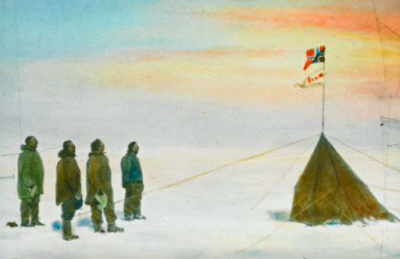Continued: the chequered origins of polar photography in colour
 |
| A colour picture of the Endurance by Frank Hurley, 1914-15 By courtesy of the State Library of New South Wales (via Wikipedia) |
Another contender for Best Polar Colour Image of the Belle Époque was Frank Hurley. Accompanying Ernest Shackleton on his aptly named Endurance expedition (1914-17), the Australian photographer made a number of colour images of the expedition’s ship stuck fast in the ice. He used a process marketed by the Paget Prize Plate Company, a would-be rival of the Autochrome. When the expeditioners had to abandon their ice-shattered ship, Hurley thought well enough of the results to take some of these images with him. But the photographs that made his name are all black-and-white.
The fact is, Captain Scott was right. As a way of efficiently representing the world in colour, neither the Autochrome nor the Paget process was ready for prime time. Indeed, Scott’s rival and nemesis, Roald Amundsen, had no truck with it. In his race for the South Pole, in late 1911, the Norwegian explorer didn’t even bring along the expedition’s large-plate camera. This left his sledgemate Olav Bjaaland (1873–1961) to document the journey with his amateurish Kodak 3 x 3, in plain black-and-white.
 |
| Amundsen's expedition at the South Pole (hand-tinted slide) Image courtesy of the Fram Museum, Oslo |
After his return to civilisation, Amundsen may have had cause to regret this photographic parsimony. Slide lectures, which were critical for defraying the costs of an expedition, depended on good imagery. And colour would make the images yet more compelling. The Norwegian explorer made up this deficit at his first homeward port of call. Taking the expedition’s negatives to a local photographer in Hobart, Australia, he had them made into hand-coloured glass positives. More were produced later. Not everybody was impressed. Scott’s widow, Kathleen, who went to one of Amundsen’s lectures, thought the hand-coloured slides looked ‘faked’.
Like Amundsen, the Swiss expeditioners were left with substantial debts to repay after their return to Zurich in the autumn of 1912. And, whether or not they actually knew of Amundsen’s gambit, they ultimately followed in his photographic footsteps.
 |
| Hand-tinted glass slide of Inuit children, by Arnold Heim Courtesy of ETH-Bibliothek, Zurich |
Probably, it was the Swiss geologist Arnold Heim (1882–1965) who actually showed them the way. On his way to inspect mineral deposits in Disko Bay, Heim had travelled with Alfred de Quervain on the latter’s first trip to Greenland in 1909. Together with the botanist Martin Rikli (1868–1951), Heim wrote up his trip in a popular book that came out in 1911. It was illustrated with hand-coloured photos showing the island’s inhabitants and landscapes.
 |
| Landscape in Greenland by the Swiss 1912 expedition Courtesy of the ETH-Bibliothek, Zurich |
In the end, none of the 1912 expedition’s Autochrome plates appeared in de Quervain’s book, except for that lone frontispiece. Instead, he took the black-and-white images to Wilhelm Heller, a professional retoucher working at Sumatrastrasse 3, Zurich, and had them hand-coloured.
 |
| Igner Ohlsen: the hand-painted glass slide version Courtesy of the ETH-Bibliothek, Zurich |
One of these was the image of Igner Ohlsen that was eventually to appear in de Quervain’s book (above). She looks notably more relaxed in the hand-coloured version, which probably reflects the shorter exposure time for a black-and-white picture.
As Heller had never been near the Arctic, he had to take his colour cues from de Quervain’s instructions. In this sense, the resulting lantern slides are tricked out in the very hues of memory itself.
References
Alfred de Quervain, Quer durchs Grönlandeis, 1914, now available in translation as Across Greenland’s ice cap, McGill-Queen’s University Press, May 2022, with more than sixty colour images from the expedition.
Patricia M Millar, "Filtering ‘ways of seeing’ through their lenses: representations of Antarctic exploration by lesser known Heroic Era photographers", MSc thesis, University of Tasmania, 2013.
Tamiko Rex, South with Endurance: Shackleton's Antarctic Expedition 1914-1917 ( the Photographs of Frank Hurley), BCL Press, January 2001.
Liz Watkins, “Mapping the Antarctic: Photography, colour and the scientific expedition in public exhibition”, Chapter 24 in Lindsay W MacDonald, Carole P Biggam, Galina V Paramei, Progress in colour studies. cognition, language and beyond, John Benjamins Publishing Company, 2018.
No comments:
Post a Comment